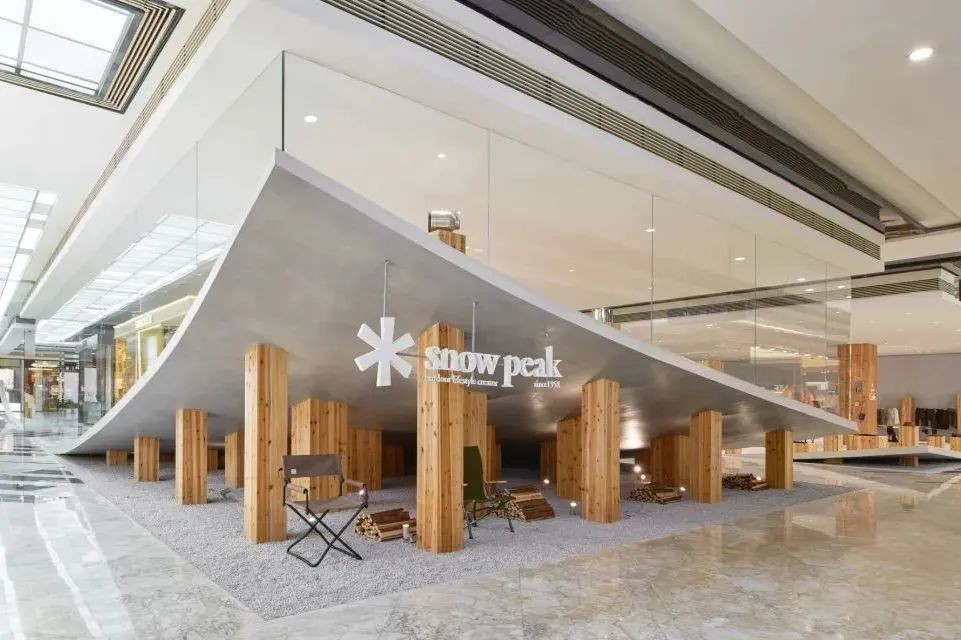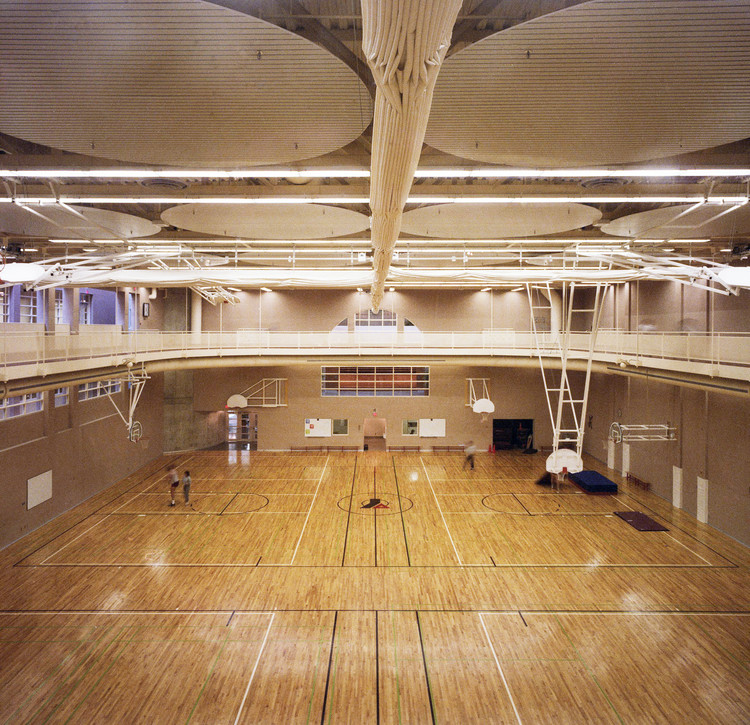Red Wall 3Gatti Architecture Studio
2013-09-28 01:00
架构师提供的文本描述。如果你在谷歌地图上显示31°16‘9.45“,121°27’14.93”,就会出现一座长方形建筑的天顶比例图,其特征是中央露台上有人行天桥横过它,还有一堵长长的艳丽的红墙,作为分隔内部区域与对面高架道路噪音的屏障。项目设计师Francesco gatti回忆道:当我们设计这座建筑时,我们把红色的外墙转向屋顶,因为我们被主要的网站可能会认出它的想法逗乐了。
Text description provided by the architects. If you digit +31° 16’ 9.45”, +121°27’ 14.93” on Google Maps, a zenith scale view will appear of a rectangular building, characterized by a central patio with pedestrian bridges crossing it and a long flamboyant red wall which acts as a barrier to separate the internal areas from the noise of the elevated road which runs opposite. The project designer, Francesco Gatti recounts: When we designed the building, we made the red façade turn towards the roof, as we were amused by the idea that the main web-mapping sites would possibly recognize it
© Shen Qiang & Daniele Mattioli
这是一种超越邻里尺度的可见性选择,乍一看,这似乎是一种自大狂-一个从太空可见的特征-。在现实中,这堵红色的墙,醒目的,夸张的尺寸,代表了整个建筑的理念,这是一个复杂而困难的项目的冰山一角,它告诉我们中国建筑的实际状况。加蒂自2003年以来一直在上海生活和工作。建筑师出身于罗马,专注于各种不同的项目:从以前工业用地的复兴,到城市地区的设计,从室内建筑到重要的国际竞争。在每一个项目中,无论是服装店还是汽车博物馆的内部,人们都能同时识别自己的概念和风格-务实和富有远见。加蒂在应对私人客户或公司的迫切需要的同时,一直努力寻找一个出色的想法,能够满足环境条件,在中国大都市的混乱和变异中,增加一个意想不到的解决方案,使项目具有独特的特色。
It is a choice of visibility that transcends the dimensions of the neighborhood and which might seem megalomaniac at first sight - a signature visible from Space -. In reality this red wall, eye-catching and with its exaggerated dimensions, is representative of the whole idea of the building, the tip of the iceberg of a complex and difficult project that tell us much about the actual state of architecture in China. Gatti has been living and working in Shanghai since 2003. The architect, who is Roman by origin, has concentrated on heterogeneous projects: from the rebirth of ex industrial sites, to the design of urban areas, from the architecture of interiors to important international competitions. In every project, whether the interior of a clothes shop or a car museum, one can always recognize his concepts and style – pragmatic and visionary at the same time -. While responding to the exigencies of a private client or a company, Gatti has always strived to find an outstanding idea, capable of satisfying the contextual conditions, adding an unexpected solution that, in the chaos and mutation of the Chinese metropolis, can give a unique character to the project.
© Shen Qiang & Daniele Mattioli
就红墙而言,这是一个特别困难的目标。该项目必须应对严重的限制:预算特别微薄,一个狭长而狭长的场地,最重要的是,投资者的无情推理,他打算对这座新建筑的每一平方米进行商业开发。因此,这位意大利建筑师提出了一个简单的设计方案:有规律的四层楼,中间空空如也,因为这对于照明注定要成为办公室的上层建筑来说是必不可少的。红墙不是用复杂的结构或昂贵的材料设计的,而是为了最大限度地利用当地资源和技术。目的是把试验集中在“皮肤”上。
In the case of the Red Wall this was a particularly difficult aim. The project had to contend with severe limitations: a particularly meagre budget, a site that was oblong and narrow and, above all, the ruthless reasoning of the investor who was intent upon commercially exploiting every single square meter of the new building. The Italian architect therefore proposed a simple design: a regular volume of four floors, empty in the centre as this was indispensable to provide light for illuminating the upper levels destined to be offices. The Red Wall has not been designed with complex structures or expensive material, but to maximize the local resources and know-how. The aim was to concentrate the experimentation on the “skin”.
© Shen Qiang & Daniele Mattioli
这一策略在世界范围内得到了广泛的应用;并且经常生产出内容平庸和外观出众的“盒子”;一次性解决方案中,一旦建筑物外观的新颖性消失,就会退回到标准化内部的匿名状态。在加蒂的情况下,预算的限制和集中在外部面部或皮肤上的决定实际上产生了双重结果,既具有雕塑性,又具有功能性。建筑的美学和同一性已经被微调到室内环境的舒适性。主要立面是由红色铝板组成的长板,呈三角形,意在被视为从对面通过高架道路的车辆内部移动。纹理的概念是由各种形状和尺寸的三角形多边形的匹配而产生的,它产生于一种直接的直觉,即主要的三维建模软件之一的图形界面的结构转换。
This strategy is used world-wide; and has often produced “boxes” with a mediocre content and a striking outer appearance; one-off solutions where buildings, once the novelty of their external appearance has worn off, have retreated into the anonymity of their standardized interiors. In the case of Gatti the limitations of the budget and the decision to concentrate on the external face or skin have in effect produced a dual result, which is sculptural and functional at the same time. The aesthetics and the identity of the building have been fine-tuned towards the environmental comfort of the interior. The main façade is a long composition of panels in red aluminium, triangular in form, intended to be perceived as in movement from the interior of the vehicles that transit the elevated road on the opposite side. The idea of the texture, produced from the matching of triangular polygons of varying forms and dimensions, was born from a direct intuition, the architectonic transposition of the graphic interface of one of the principal software for 3D modeling.
© Shen Qiang & Daniele Mattioli
红墙的主要外观是完全二维的;然而,构图的图案创造了一个奇怪的光学网格效应,这似乎创造了一个浮雕运动。通过这种方式,加蒂获得了一个令人惊讶的结果,优化了手头的资源:为了实现这一点,没有比普通的面板更多的铝了。“红墙”是厚厚的,有线性和狭窄的开口,以限制因交通的存在而造成的声和视觉污染。注定要承载技术设备的小型外墙被隐藏在第二个网眼后面-这是一种竹子板的图案,其特点是它们的尺寸各不相同,并在一定程度上突出。外观的“皮肤”具有雕塑的效果,其宽度提供了防止过热所必需的阴影。“红墙”这一14300平方米的多功能建筑诞生于2008年,同年开始施工。在短短几天的时间里,加蒂和他的合作者们从一个令人信服的建议转向了为建造工程所必需的技术设计。
The principal façade of the Red Wall is completely two-dimensional; however, the pattern of the composition creates a strange optical mesh effect which seems to create a relief movement. In this way Gatti obtains a surprising result, optimizing the resources to hand: to effect this, no more aluminum was used than for an ordinary facework. The “red wall” is thick and has linear and narrow openings in order to limit the acoustic and visual pollution resulting from the presence of traffic. The minor façades, destined to host the technical apparatus, have been hidden behind a second mesh – a pattern of bamboo panels characterized by their varying dimensions and to the extent they jut out. The “skin” of the façade gives a sculptural effect and its width provides the shade necessary to prevent over-heating. The concept of the “Red Wall”, a multi-functional structure of 14300 square meters, was born in 2008 and the construction was carried out during the course of the same year. In the space of a few days Gatti and his collaborators moved from a convincing proposal to drawing up the technical designs necessary for the construction.
© Shen Qiang & Daniele Mattioli
建筑工地是在几天后开始的,有着资本主义中国那种不人道的节奏。中国是一个规模为1:1的模式,每个人-承包商、业主和建筑师-都一天地决定细节,而不遵循“传统”建筑的合理组织方式。劳动力成本如此之低,以至于有可能像建筑模型一样,试验、做、撤销、建造和拆卸整个部分。
The building site started a few days later and had the inhuman rhythm of capitalist China, a model on the scale 1:1 where everyone – contractor, client and architect – decided the details day by day without following the rational organization of a “traditional” construction. Labor cost so little that it was possible to experiment, do and undo, construct and demolish entire parts, like an architectural model.
 举报
举报
别默默的看了,快登录帮我评论一下吧!:)
注册
登录
更多评论
相关文章
-

描边风设计中,最容易犯的8种问题分析
2018年走过了四分之一,LOGO设计趋势也清晰了LOGO设计
-

描边风设计中,最容易犯的8种问题分析
2018年走过了四分之一,LOGO设计趋势也清晰了LOGO设计
-

描边风设计中,最容易犯的8种问题分析
2018年走过了四分之一,LOGO设计趋势也清晰了LOGO设计






























































